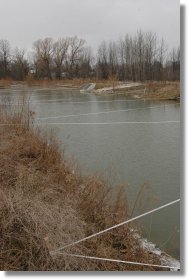
Goose Control
 You may have noticed that Township staff and volunteers have been stringing rope across the stormwater pond beside the park on Cooper Drive. This program is being done to help control the over-population of geese.
You may have noticed that Township staff and volunteers have been stringing rope across the stormwater pond beside the park on Cooper Drive. This program is being done to help control the over-population of geese.
In some places like the storm pond next to the Dufferin Marsh, Canada Geese have become a nuisance. The habitat created by people for people (like parks and storm water ponds), are the places where geese, in very large numbers, want to nest and raise their young. These areas provide geese with nest sites, water refuge (protection from predators) and open expanses of nutritious (fertilized) and desirable grasses. An adult goose will eat up to 2 kilograms of grass daily and produce as a result up to 1 kilogram of fecal material. The fecal waste is unsightly, smelly, and unattractive to walk through or play around. As a result, people stop using these areas and the geese get more comfortable. When the fecal matter is washed away it causes concerns for water quality.
During the nesting period and while geese are raising their young they can become very aggressive. Geese will chase away predators, other geese, dogs, and people. Their behaviour is not just an act. They have been known to inflict severe bites and even break peoples arms. This behaviour also dissuades people from sharing an area with geese.
Geese can make life uncomfortable for people, but none would want to eliminate them completely. So what can we do to resolve the conflict and find the balance?
The best solution is to discourage over-population of geese by modifying the urbanised habitat, recreating some of the elements of a natural habitat. There are several strategies that can be used in combination to be most effective.
- Leave or plant a buffer of tall grasses, trees and shrubs between the water area where the geese find refuge from predators and the food source. Large rock obstacles can be added to the buffer. This situation makes the geese uncomfortable, particularly during periods when the adults and young cannot fly.
- Alter the grass mix to include native grasses that are stiffer stemmed and less palatable.
- If the pond is small, install low fence barriers around the water.
- A grid of string, or wire can be suspended over the water which significantly reduces use by water fowl.
- If possible, eliminate islands or peninsulas in the ponds reducing the safe areas used for loafing and preening.
 Active solutions are also helpful.
Active solutions are also helpful.
- Do not feed waterfowl. This practice encourages geese to stay in an area, and makes geese less cautious. Typically the food is low in nutritional value and may lead to avian diseases.
- Harassment techniques, including using loud noises or chasing, can be used to frighten and discourage geese. These techniques are most effective when used early in the season before nest territories are established and must be repeated until the geese leave. As Canada Geese are a protected species, you must check with the Provincial Ministry of Natural Resources or Environment Canada before taking this approach.
- In areas where geese pose a severe problem, reproduction can be discouraged through techniques such as oiling eggs to prevent hatching; numbers can be reduced by trapping and relocation programs; or, special hunting seasons can be established. These approaches require the involvement of the Ministry of Natural Resources or Environment Canada and your local municipality.
As we watch the geese return in the spring we instantly recognise the cycle of nature. Through a small but considered effort we can invite geese to share our habitat giving them a place to live, and us an opportunity to observe a small wonder of nature without conflict.
Here at the storm pond we have decided to use the least invasive and least disruptive technique possible - the addition of the goose rope.
If you have any questions on the control activity, please contact Mary Asselstine, the Dufferin Marsh Co-ordinator at the Parks, Recreation and Culture Department for the Township of King at (905) 859-0056.